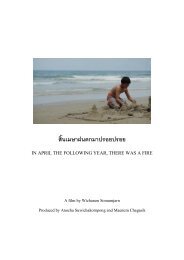francisca gavilán digna quispe catalina saavedra - Pascale Ramonda
francisca gavilán digna quispe catalina saavedra - Pascale Ramonda
francisca gavilán digna quispe catalina saavedra - Pascale Ramonda
You also want an ePaper? Increase the reach of your titles
YUMPU automatically turns print PDFs into web optimized ePapers that Google loves.
The fact that the story happened in 1974, during Pinochet’s dictatorship, wasalmost more complicated. Since my parents were exiled, the subject of thedictatorship was an everyday thing during my childhood. It was spoken of overbreakfast, and it is a subject that I’ve always been reluctant to touch: you couldsay I had antibodies. I found that it was interesting to talk about it but from adifferent place, from a different culture and from the absolute fringe. The dictatorshipis something that arrives to the Quispe sisters as an echo of a farawayworld, not as something tangible and everyday in their lives. Life under thedictatorship is information that arrives from the distant world of the city, andwhich in the gigantic space that is the altiplano desert, takes on other formsand becomes a nightmare. From this point of view, the subject was approachableto me.How did you carry out the investigation? In what way did you approachthe shooting, the casting?The story is based on true events, and this is why I decided to go and livein the mountains for two months with one of the last coya families of thecommunity that the Quispe sisters belonged to. This was done, above all, inorder to hear the stories and gain a better understanding of their imagery,and not really to search for a verism, which I wasn’t interested in. I knewthat I wanted to shoot a fiction film and not a purist documentary.I was interested in documenting the spaces, the “rucas”, this is, the cavesor huts that coya shepherds build in the mountains to live in for a fewmonths during the summer. They were surprising to me, and I felt that Ihad to leave a visual testimony of them. All the rucas that can be seen inthe film were built by coya shepherds, and the place in which the Quispesisters live in the film is the last ruca that they actually lived in. The rockwhere they carry out their final ritual was the same rock that the Quispesisters chose.I shot the film with a small team of eleven people, because I felt that morepeople might “invade” these spaces with their walkie-talkies and all of thegear that more industrial film entails. I also did this so that the non-actorswho act in the film, who belong to the last two families that live in theplace, would feel less invaded and calmer in their natural environment.In the case of the elder sister’s character, Justa, I chose Digna Quispe, whomI met while scouting locations. Digna is the Quispe sisters’ niece, and the lastperson who saw them alive. But I chose her mostly because I made a screentest with her in the mountains, during a small break that she took between herchores with the animals, and I liked the way she acted. But later, during theshooting, she surprised us all with her tremendous acting level.At first, I thought about working exclusively with non-actors, but soon dismissedthe idea. First of all, because there is practically no one left in this place.The film speaks of the depopulation of a space, and this is what happened. Andin general, in films that are made with non-actors, especially if they belong toa different culture, a relationship, a vertical perspective tends to take place. Igreatly admire Pasolini, who mixed actors and non-actors and took it to a poeticspace that had a reality of its own. My idea was for the actors to contributetheir technique to the drama’s interpretation and for the non-actors to bring inthe tone, the documentation of a way of life. In some way, I always thought ofit as a graft, with a dialogue that could deliver its own representation of thisstory. Catalina Saavedra and Pancha Gavilán are two tremendous Chilean filmactresses who adapted to the place’s rough conditions and to working with theanimals. Working with them was a privilege.These women are like foreigners in their own country, far away frominhabited places. Is this something that you intended to delve into: isolation,rural areas?More than isolation, what I was interested in delving into was the fact thatthey lived in a different cultural time than that of the city, which is Chilean andtherefore occidental, as well as under a dictatorship. The dictatorship broughtalong with it the idea of a new order: the modernization of business, rationalization,to safeguard the erosion of wages produced by the animals, and therefore,conducive to the prohibition of their shepherding. It also brought along theprohibition of dynamite possession for small miners out of fear of acts againstthe government. This ended up depopulating the mountains completely. And onthe other hand is the life of these shepherdesses, with an ancestral culture inwhich animals form a vital part of their lives, just like the mountains, the rocks.These two times, which do not know how to dialogue, that are unable to findand understand each other, are what interests me.



